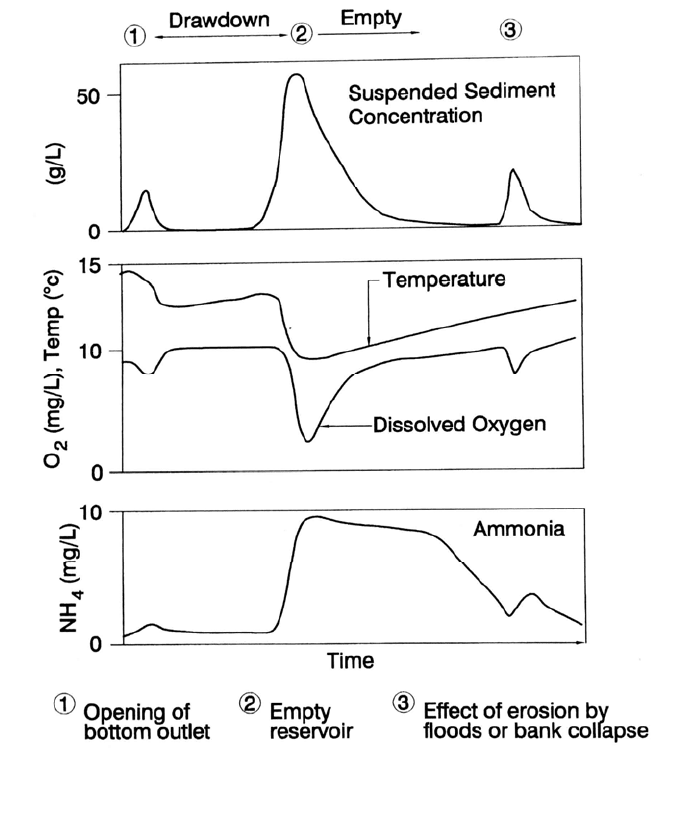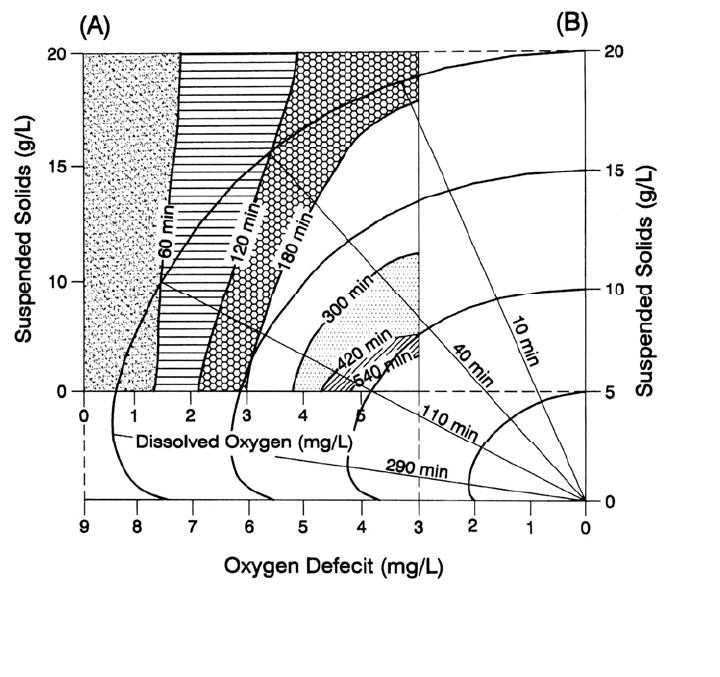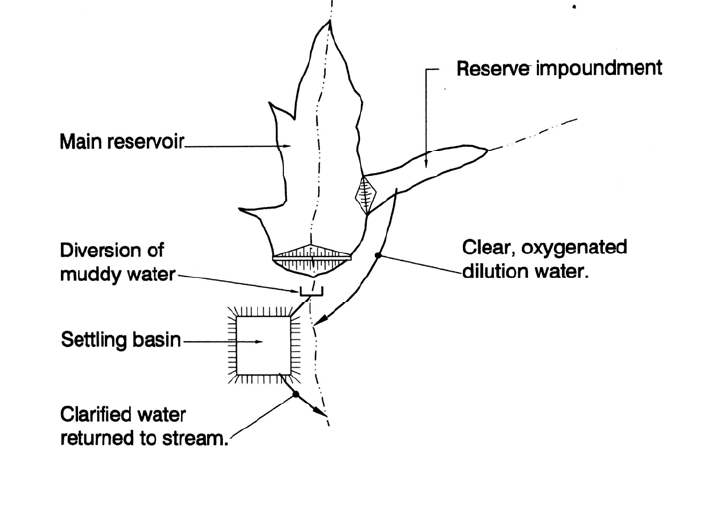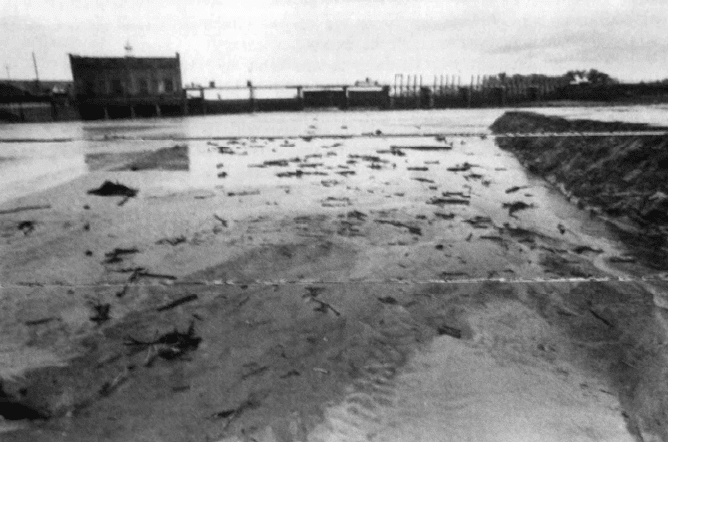Morris & Fan. Reservoir Sedimentation Handbook
Подождите немного. Документ загружается.


ENVIRONMENTAL AND REGULATORY ISSUES 18.19
18.4 RESERVOIR EMPTYING AND FLUSHING
The largest and most intractable downstream environmental impacts associated with
sediment release from reservoirs are caused by reservoir emptying and flushing. The
types of impacts described in this section will occur any time a reservoir is emptied, but
with wide differences in severity. Material in this section relies heavily on experience in
France and Switzerland as reported by Electricité de France (EDF. 1995), Gerster and
Rey (1994), and discussions with Petitjean and Bouchard (1995).
There are two opposing schools of thought on the subject of reservoir emptying. One
proposes that downstream environmental impacts should be minimized by keeping the
trapped sediment within the pool. While this is feasible initially, sediment cannot
accumulate indefinitely and at some point in time sediment must he discharged or
removed by dredging. The opposing school of thought is to allow sediments to escape
during emptying, but to mitigate deleterious effects.
18.4.1 Water Quality during Reservoir Emptying
Probably the most comprehensive analysis of the downstream impacts of reservoir
emptying has been undertaken by Electricité de France, which operates about 500 dams
and has published guidelines for reservoir emptying (Electricité de France, 1995).
French law requires reservoir emptying at larger dams for safety inspection at 10-year
intervals, resulting in 10 to 15 emptyings annually at EDF facilities. Even though the
objective of these emptyings is not to preserve reservoir capacity, bottom sediments
are flushed out as an inevitable consequence of the emptying, and sediment
management techniques are employed. French reservoirs typically do not have large
amounts of sediment accumulation; sediment concentrations and downstream
loadings can be much higher at reservoirs with high sediment loads, or many decades
of accumulation. When large volumes of sediment are to be removed by flushing, there
may be no practical method for mitigating downstream impacts except by timing the
flushing release.
Monitoring of French reservoirs by EDF revealed the characteristic sequence of
water quality changes illustrated in Fig. 18.13 and described below.
1. Opening of the bottom gate releases sediment immediately in front of the outlet,
causing a relatively small perturbation in the quality of the released water as
sediments are eroded to create a scour hole. Sediment that accumulates in front of the
gate will typically be transported as wash load through the downstream channel by
the higher quality water that continues to be released after the initial scouring.
2. Water quality remains steady or changes gradually until the end of the
emptying process. During this period, deposits eroded from the channel scoured in the
upper area of the reservoir are transported toward the dam, but little sediment is
released.
3. At the final stage of emptying, the establishment of riverine flow along the length
of the reservoir and through the bottom outlet causes dramatic and rapid changes
in water quality as bottom muds are washed out of the empty pool. Suspended solids
concentrations are measured in tens of grams per liter, dissolved oxygen levels
are depressed and may reach zero as anaerobic bottom water is released and the
organic muds exert an oxygen demand, and ammonia concentration increases. This
drainage of bottom muds represents the most severe water quality problem posed by
emptying, and peak suspended sediment concentrations on the order of 100 g/L
can occur (Petitjean and Bouchard, 1995). The concentration and duration of the
release depend on factors such as the amount and characteristics of the sediment
deposits and the discharge rate.

ENVIRONMENTAL AND REGULATORY ISSUES 18.20
FIGURE 18.13 Sequence of water quality changes that accompany the release of water during
reservoir emptying (Electricité
,
de France, 1995).
4.
Following release of the bottom mud, water quality tends to improve throughout
the duration of the empty period. Bank slides, small floods which scour
sediment, and rainfall erosion of exposed sediment can temporarily increase sediment
discharge during the empty period.
This general sequence is also reflected in the available data from reservoirs
emptied for sediment flushing, as illustrated in case studies for Gebidem, Cachí, Sefid-
Rud, and Heisonglin.
18.4.2 Fisheries Impacts
Virtually all the fish in a reservoir will he flushed downstream or killed during emptying,
and fish nests will be desiccated. Fish downstream of the dam can be affected by:
ENVIRONMENTAL AND REGULATORY ISSUES 18.21
1. Physical blockage of gills by high sediment concentration, essentially causing
suffocation;
2. Reduced dissolved-oxygen levels;
3. Washout of nests and fry if unseasonably large flows are released during
flushing;
4. Modification of the benthos due to sediment deposition;
5. Modification of the aquatic population structure;
6. Disruption of the aquatic food chain and elimination of food sources, especially
on the benthos; and
7. Incorporation of toxic substances into the food chain if reservoir sediments
containing toxins are released during flushing (agricultural chemicals, mine
tailings, etc.).
The physical stresses induced by flushing can produce fish kills, reduce resistance to
disease, reduce growth rates, and cause genetic problems if toxins are present. Release of
a large sediment volume at high concentration will kill virtually all stream biota.
Drastic fish mortality has been observed downstream of French reservoirs which
are drained, primarily because of reduction in dissolved oxygen and high suspended-
solids concentration. Garric et al. (1990) studied the effects of emptying the Saint
Hilaire reservoir on water quality and fish mortality in the Isère River. Comparison
of laboratory and field data suggests that hypoxia (oxygen deficiency) was the
major cause of fish mortality during dam draining, with larval stages being much
more susceptible than adults. Ammonia concentrations were never high enough to
he considered a contributing factor, and temperature and pH values during the
draining were not significantly affected. It was concluded that a better knowledge of
fish acclimatization to depressed oxygen levels could lead to the adoption of a
progressive draining protocol to let fish better adapt to hypoxia before being
submitted to an anoxic period.
The dissolved oxygen concentration in the river below the dam during flushing is
determined by: (1) the oxygen level in the hypolimnic water that is released through the
bottom outlet, (2) the oxygen demand exerted by the sediment that is released with the
water, and (3) the rate of reaeration within the stream by gas transfer from the
atmosphere plus photosynthetic activity by aquatic algae and bottom plants. These
parameters are influenced by a variety of factors, including temperature. The saturated
oxygen content is lower in warm water than in cold water, and the higher rate of
biological activity in warm water consumes the limited oxygen supply more quickly.
This makes it increasingly difficult to sustain dissolved oxygen levels as water
temperature increases.
18.4.3 Predicting Downstream Water Quality
Oxygen and suspended sediment concentration below a dam during flushing may be
estimated by modeling which includes parameters for the transport rate, reaeration rate,
and the reduction in sediment concentration due to deposition. The initial oxygen
concentration, that of the hypolimnic water, must be known, and the oxygen consumption
kinetics of the sediment must be determined for the temperatures that will prevail
during flushing. When a range of sediment sizes are present, the oxygen consumption by
sediment should be determined for the fines; coarse sediments exert little oxygen
demand. The timewise variation in sediment concentration over the duration of flushing
will also need to he computed.
Fish mortality increases as a function of decreased dissolved oxygen levels, increased
suspended-sediment concentration, and increased exposure time (Fig. 18.14). Ideally,

ENVIRONMENTAL AND REGULATORY ISSUES 18.22
FIGURE 18.14 (a) Isolines for 10 percent mortality of trout alevins as a function of dissolved
oxygen, suspended sediment concentration, and exposure duration (Garric et al., 1990). (b)
Superposition of predicted oxygen deficit and suspended concentration due to flushing on
data for trout mortality (Gerster and Rey, 1994).
m
odeling could determine the sediment concentrations and dissolved oxygen levels at
different points below the dam as a function of the flushing regime, and this
information could be used to predict impacts and optimize flushing procedures. In
practice, computations of this nature provide only rough approximations of field
conditions. One of the principal parameters to be analyzed is sediment release during
flushing. Present state-of-the-art modeling with ample field data, including reservoir
borings, allows the volume of sediment release to be predicted within the range of
about -50 to + 200 percent of the actual discharge when cohesive sediments are present.
Greater errors should be expected if less effort is dedicated to field data collection and
modeling activities. A large part of the uncertainty is attributable to the difficulty in
specifying erosion rate and equilibrium conditions for cohesive materials with complex
bedding (Petitjean and Bouchard, 1995). Impacts to the benthos are more difficult to
predict. Planning of reservoir emptying should consider the uncertainty in predicting water
quality conditions, and in sensitive areas these plans should include contingencies to stop
the release and flush the stream with clear water.
18.4.4 Reservoir Ecosystem
Reservoir ecosystems typically develop through a series of successional stages as the
system matures. After first filling, the water nutrient conditions stabilize, fast-growing
pioneer species give way to more diversity, and species populations grow and stabilize
with respect to their age-class distribution. Emptying a reservoir eliminates large compo-
ENVIRONMENTAL AND REGULATORY ISSUES 18.23
nents of the ecosystem, including virtually all fish and those benthic species unable to dig
into mud and survive the dewatering period. During the first years following emptying,
the fish face an ecosystem abundant in food, water quality is good because of oxidation
of sediments during emptying, and interspecies competition is weak. Studies in French
reservoirs recovering from emptyings followed by 10 years of impoundment revealed that
fish populations in these manipulated ecosystems tend to be characterized by unequal
population distributions: both older and younger age classes were overrepresented,
whereas the intermediate age classes were underrepresented. This phenomenon
becomes more pronounced as the ecosystem ages. The initial restocking after refilling is a
primary determinant of the "trajectory" along which the lacustrine ecosystem develops
during the impounding interval.
18.4.5 Water Supplies
Reservoir emptying and flushing can have a large impact on municipal, industrial, and
irrigation water supply intakes. An alternative water supply source will need to be
provided for intakes located in the reservoir when it is empty. Downstream intakes and
diversion channels can be physically clogged by high sediment concentrations, as can
heat exchangers at industrial facilities drawing cooling water from the river. The solids-
handling facilities at filter plants can be overloaded, especially in facilities designed for
operation with water normally having low suspended solids. Fine sediment can clog
infiltration galleries beneath the streambed. The water may be anaerobic with high
concentrations of dissolved iron and manganese, and organics such as methane may react
with chlorine to create chlorinated hydrocarbons. Taste and odor problems may be
anticipated. It may be necessary to temporarily close water supply intakes, implying an
alternative water source (e.g., from a storage basin). The period of water supply
disruption can be estimated by water quality monitoring below the dam, dilution by
tributary inflow, and hydraulic travel time.
18.4.6 Timing, Coordination, and Public Relations
Some irrigation reservoirs are heavily drawn down or emptied on an annual basis, in
which case emptying for sediment flushing or pass-through should be conducted in
conjunction with the existing drawdown schedule, extending or modifying it as
necessary. In reservoirs not normally subject to heavy drawdown, the following factors
should be considered.
Emptying can be performed only when inflows are significantly less than the
discharge capacity of the bottom outlet. It should be possible to pass the river flow
with little or no backwater upstream of the bottom outlet.
Maximum sediment release will occur when emptying coincides with high flows that
will scour sediment deposits. When it is desired to minimize sediment release during
emptying, avoid periods of high streamflow.
Emptying should be timed to minimize impacts to beneficial uses and the
environment. In some cases it will be important that the reservoir refill quickly. In
others it may be desirable to avoid periods of recreational use in the reservoir or
downstream river, to avoid ecologically sensitive periods such as spawning, or to
coincide with specific hydrologic conditions in a downstream river to provide
dilution flows [e.g., see Gehidem case study (Chap. 21 )]. Particular attention should
also be given to life cycles of benthic organisms which occupy the base of the
aquatic food chain.

ENVIRONMENTAL AND REGULATORY ISSUES 18.24
There may he other activities that can he facilitated when the reservoir is empty, and,
with advance coordination, multiple benefits can be achieved. Activities
facilitated in an empty reservoir may include: any work in and around the
dam and hydropower facilities; rehabilitation of intakes, screens and gates;
excavation of navigation channels; repairing of marinas, boat ramps, and beach areas;
bank stabilization; photogrammetric reservoir surveys; sampling of sediment
deposits; and timber harvest areas near the lake.
In areas of France dependent on reservoir-based recreation, and where
emptying impacts the recreational season, alternative recreational events have been
staged such as fishing competition as the lake is being lowered, dirt bike racing in the
empty reservoir, concerts, and visits to villages submerged by the reservoir,
Unorganized recreational activity on the bottom of Folsom Reservoir in
California is shown in Fig. 18.15.
FIGURE 18.15 Off-road vehicle recreational use of the bottom of Folsom Reservoir, California,
during drawdown as a result or prolonged drought (G. Morris).
Fish
kills are a highly visible indicator of environmental damage. When a reservoir
is drained, the fish within the reservoir are either flushed downstream (where many of
them die) or they are crowded into the shrinking reservoir pool until it empties.
After emptying, dead fish may be found on the banks of the drained reservoir and along
the downstream river. At French reservoirs, intensive fishing is performed prior to
and during draining with the objective of catching all fish in the reservoir.
Despite the promotion of recreational fishing contests during this period, it has
been found necessary to contract commercial fishermen to attain the high catch
efficiency that is desired. At the end of the drawdown period, when many fish are
being flushed out the bottom outlet, discharge is directed across a bar screen which
catches the fish. These fish are sold or given away to local residents. The
banks of the reservoir and downstream river are patrolled to remove all dead or
dying fish. If the reservoir remains empty for an appreciable period during the
ENVIRONMENTAL AND REGULATORY ISSUES 18.25
summer, the exposed banks may be seeded with fast-growing grass to reduce rainfall
erosion and enhance the aesthetic appearance. After refilling, the reservoir is
restocked with fish.
The coordination and communication required prior to emptying is site-dependent.
EDF begins planning and coordinating emptyings about 30 months in advance.
Emptyings are generally timed to coincide with the driest part of the year, and the
empty period may last for several weeks, depending on the programmed
maintenance work. Refilling may be further delayed by low water. In Costa Rica the
annual flushing of Cachí Reservoir is planned about 6 months in advance and
scheduled to coincide with a long weekend when electrical demand is low.
Because flushing occurs annually and there is little development in the area,
coordination efforts in Costa Rica are minimal compared to France.
Potentially affected users, regulatory agencies, and government authorities
bordering the lake and downstream should be identified and contacted. These may
include: operators of all water intakes; wastewater plant operators who may
depend on dilution flows of a stated quality to meet instream water quality standards:
national, state, and local agencies regulating water quality and aquatic life; and
political representatives such as mayors. It is also important to contact recreational
users such as marinas, fishing clubs, and tourist associations and to coordinate emptying
to minimize impacts to their members and clients insofar as possible. Emptying dates
should he coordinated to minimize impacts to seasonal recreational users, especially
when seasonal recreation is a major economic activity in the area. Because of the
numerous reservoir drainings performed each year, EDF has prepared a public
relations video which describes the emptying process and typical mitigation
activities.
18.4.7 Water Quality Mitigation Measures for Flushing
Reservoir emptying can reduce oxygen levels downstream by: (1) the release of oxygen-
depleted hypolimnic water, (2) the oxygen demand exerted by organic sediment, and (3)
increased turbidity which shades instream primary producers. In some cases, low
dissolved oxygen can be mitigated by artificial oxygenation. Fish have improved
tolerance to suspended sediment if dissolved oxygen levels are high, and to a certain
extent high sediment levels can be compensated by aeration. However, if the
oxygen demand exerted by released sediment exceeds the natural reaeration rate
along the river, oxygen depletion may occur downstream despite adequate oxygen
levels at the dam. At reservoirs in France it has been found that dissolved
oxygen levels can be elevated about 2 to 3 mg/L by reaerating with atmospheric
oxygen, and 6 to 8 mg/L can he achieved when reaeration is performed with pure
oxygen. Either floating or submerged aerators may be used. In air bubble systems,
best results are achieved by using the smallest possible bubble size and the deepest
possible placement depth (over 2 m) to maximize oxygen transfer. However, a
bubbler should not be installed directly on the bottom where it may he smothered by
sediments. Aeration systems may also he installed upstream of the dam to improve
hypolimnic water quality prior to release.
Releases containing a high suspended-sediment concentration can he captured and
treated in either off-stream or on-stream settling basins below the dam.
Sediment trapped in an off-stream settling basin may be removed by dredging, or
dewatered and then trucked away, thereby restoring basin capacity for the next
flushing event. Sediment trapped in an on-stream basin located within the river
channel below the dam may he scoured and transported downstream by hydraulic

ENVIRONMENTAL AND REGULATORY ISSUES 18.26
action during subsequent flood events, which would also provide dilution water.
Sedimentation basins may operate in a continuous flow-through mode, with
sediment-laden water continuously entering he basin and clarified water being
continuously discharged. Alternatively, they may be operated in batch mode by filling
a basin with muddy water, allowing it to settle, and releasing the clarified supernatant.
Design procedures for settling basins are given in Chap. 16.
If the stream normally sustains a low flow, it will be necessary to maintain the low
flow by using water of adequate quality from another source while the muddy water
is being diverted into settling basins. Options include the controlled release of clarified
and oxygenated water from previously filled settling basins or the construction of
a small reserve impoundment within the main reservoir which would supply clear
water to the stream by canal or pipeline when muddy flow is diverted (Fig. 18.16). A
FIGURE 18.16 Potential use of reserve impoundment and sedimentation basin to mitigate
downstream effects of reservoir emptying.
reser
ve storage compartment may have additional uses as well, including the provision of
dilution water during flushing, even when muddy water is not being diverted into settling
basins. After the release of muddy water, the bed and banks of the stream will typically
be covered with a layer of fine sediment (Fig. 21.10). A large clear water release
following the release of muddy water may be used to scour and flush fines
downstream.
18.4.8 Monitoring
Monitoring should be conducted before, during, and after flushing. Pre-flushing
water quality data should be available for the downstream river, and the vertical
stratification condition in the reservoir should be monitored to determine the
temperature and dissolved oxygen levels in the bottom water to be released. Sampling
and analysis of reservoir sediments is required to determine the oxygen uptake
ENVIRONMENTAL AND REGULATORY ISSUES 18.27
kinetics of the fine sediment and the chemical characteristics of the interstitial
water.
Routine monitoring during flushing should focus on parameters such as suspended
sediment concentration and grain size, dissolved oxygen, temperature, forms of
nitrogen, total and orthophosphate, and pH. Additional parameters may be required,
depending on site conditions. Data collection should normally focus on: (1) monitoring
water quality to control the operation of water supply intakes, (2) the collection of
information that will help predict the impacts of future flushing operations, and (3) data
required for the validation of predictive models. In monitoring water supply intakes,
parameters such as turbidity would normally be used in addition to suspended
sediment, since the processing of suspended sediment samples is time-consuming,
even with filtration and microwave drying. Selected cross sections may be surveyed
before and after flushing to determine the depth and grain size of sediment
deposition, and gravels may be sampled to monitor the entrainment of fines.
Reservoir emptying and flushing can have large impacts on the benthic
community in the downstream river because of both water quality changes and sediment
deposition. The population and species composition of the benthos can change
seasonally, and long-term monitoring is required to understand seasonal effects and
separate them from the effects of reservoir emptying. The choice of monitoring points is
important, and monitoring stations should be established at several points below the dam
representative of different stream environments. For example, monitoring results
will be biased if all sampling stations are located in pools or near the shoreline
where sediment deposition is most likely, or in midchannel riffles where sediment
deposition is least likely. Aquatic ecosystems on regulated rivers are heavily impacted
by the changes in hydroperiod, sediment transport, peak discharge, temperature,
migration barriers, and other effects of the dam, It may be difficult to separate these
effects from those caused by reservoir emptying and flushing, and it may be difficult
to find a representative paired river (control) for the purpose of comparative long-term
monitoring (Electricité de France, 1995).
18.4.9 Flushing at Spencer Dam, Nebraska
Biological impacts and mitigation recommendations for sediment flushing at the small (1
MW) low-head Spencer hydro station on the sand-bed Niobrara River, Nebraska, were
reported by Hesse and Newcombe (1982). The dam, located 63.3 km upstream of the
Niobrara's discharge into the Missouri River, operates as a run-of-river hydropower
station. Mean annual flow at the dam site is 1.3 m
3
/s, and the river transports mostly
sands. The low dam has no bottom outlet, and flushing is conducted by opening radial
gates and allowing sands and fines to be scoured and discharged over the gated spillway
(Fig. 18.17). After about a week of flushing, the gates are closed and the impoundment
is refilled. Although the dam is very small, and the volume of sediment release is
not large, the impacts on water quality and stream ecology are significant.
Water quality along the entire 63-km reach of the Niobrara between the dam and
the Missouri River confluence is affected by the flushing. A comparison of flushing
flows to ambient conditions at a station 60 km below the dam shows that flushing
caused: a turbidity increase of 400 percent [240 versus 56 Jackson turbidity units
(JTU)]; a 15-fold increase in settleable solids; a 4-fold increase in suspended
solids; and a 2-fold increase in dissolved solids.
The impoundment was flushed 22 times in 5 years. Significant fish kills were
reported in four of these instances, affecting nearly 30 species. Fish were most affected
in the immediate vicinity of the dam, and the documented fish kills occurred during

ENVIRONMENTAL AND REGULATORY ISSUES 18.28
FIGURE 18.17 Spencer Dam on Niobrara River, Nebraska. View looking downstream across
sand sediment deposits being scoured from the empty pool (G. Morris).
t
he summer and fall, when the largest fish populations occur in the zone below the dam.
One kill of 22,47 individuals was counted (of which 18,000 were minnows). This
undercounts actual fish loss, since fish stranded behind rocks and depressions during
flushing were quickly buried by up to a meter of sediment, and other fish in extreme
distress floated downriver. For most species, young-of-the-year and yearlings were the
most affected. Fish were affected by depressed oxygen levels (but not anoxia), high
suspended-sediment levels, high flow velocities, and physical smothering by sediment,
and the exact cause of death was difficult to establish. The impacts of sediment release
on the stream ecosystem extend well beyond the flushing period itself because the
benthos becomes smothered. As a result, macroinvertebrates were even more acutely
affected than fish, disrupting the aquatic food chain.
The following management techniques were recommended to minimize downstream
impacts.
1. Time flushing to avoid spawning periods, April 15 to September 15 on
Niobrara River.
2. Flush less frequently (annually) to maximize recolonization of the stream by
insect macroinvertebrates.
3. Refill the reservoir slowly so that stream flow below the dam is not reduced below
6 percent of natural mean monthly flow.
4. Establish mitigation programs to offset fish loss.
5. Develop a fish ladder or bypass system.
5. Monitor to evaluate effects of the recommended actions.
Hotchkiss proposed a continuous sand bypass system at Spencer Dam which would
discharge sandy sediment on an essentially continuous basis, as opposed to the highly
irregular release caused by flushing.
